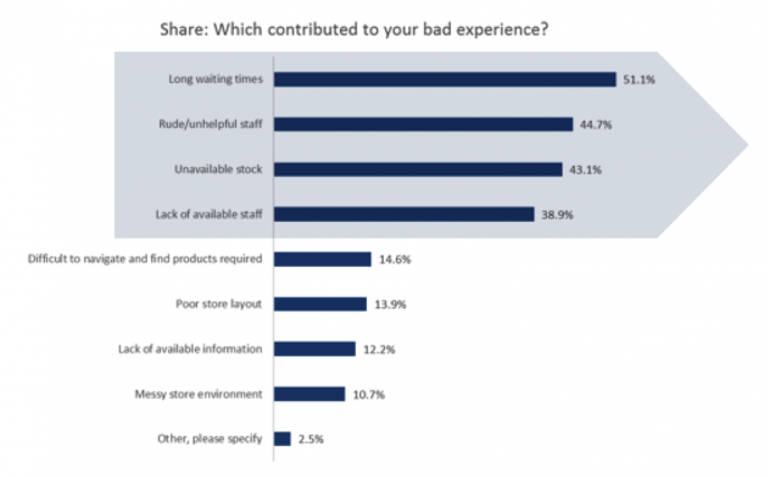The Ultimate Guide to Customer Experience

Table of Contents
CX is much more than feedback surveys and pretty dashboards. It’s being customer-centric in everything you do
Customers probably don’t remember every single experience they’ve had in stores. You tend to remember two experiences as customers: a great experience and a poor experience.
Positive customer experience is crucial to any business. Happy customers are more likely to become loyal customers who boost revenue through word-of-mouth marketing and advocating for your company.
How you view customer experience impacts how you view your business as a whole. That’s why it’s essential to create and obsess over providing an excellent customer experience - or improving it.

What is customer experience (CX)?
The customer experience (CX) is how a business engages with customers throughout the buyer’s journey. It results in the customer’s view of your brand and impacts its bottom line, including revenue.
Customer service is critical to not only retaining customers but also attracting new ones.
People and processes
Customer experience links to employee experience. Research proves that companies with excellent customer experience have1.5 times more engaged employees than companies with poor customer experience records.
Even without the research, it’s common sense. Disgruntled employees do not provide excellent customer service. Companies who invest in employee experience see a higher return on investment (ROI) than those who don’t.
So, how do you create a culture of engaged employees? If employees feel they are an integral part of their company and are respected, trusted, and valued, they’ll be more engaged.
A company that is well-known for its unique corporate culture is Costco. Any Costco you go into, you’ll find friendly and courteous employees who strive to ensure the customer experience is always above and beyond. Why? Because Costco takes care of their employees. In 2017, they were named the top place to work.
So, what’s so great about the Costco culture and employee experience? They treat their employees like family, not just a means to an end.
Culture and strategy
A well thought out strategy can help establish your company’s values. It will also provide a consistent framework for how customer service is provided.
A customer-centric business model provides a positive customer experience before and after the sale to drive repeat business and increase business growth. However, customer-centric companies must offer more than just good customer service.
Amazon and Zappos are perfect examples of customer-centric companies. They spent years creating a culture that emphasises customers and their needs. Zappos is even known to enthusiastically fire employees that don’t fit in their customer-centric culture.

So, why are customer-centric strategies critical for businesses today? In the late nineties (and especially in the last decade), customers became more selective in which brand they spent money on. Brands that offered excellent service and built a relationship with customers are the chosen heroes. At the same time, another game-changer entered the arena - social media.
Social media marketing changed the way customers interact with products and services. Global Web Index reports that 54% of individuals use social media to research products and are 71% more likely to purchase a product based on social media referrals.
Shifting towards customer-centric business models can have significant benefits for customers and employees.
Products and services
A great customer experience also comes down to the products and services that you offer. And it’s not just about flashy one-off stories.
The Ritz-Carlton is the master of customer experience. The Ritz is renowned worldwide because it empowers employees to provide an excellent customer experience to everyone that passes through its doors. One of the most notable policies the brand has is its customer experience stipend.
The Ritz allows employees to spend up to $2,000 per incident to resolve customer issues - without asking for manager approval.
You may not have $2,000 to spend per incident, but you can still empower your employees to do what needs to be done at the moment. Give them the ability to provide refunds, discounts and even bend the rules if need be.
Customer Experience vs Customer Service
Can customer experience and customer service be used interchangeably? Well, no. They are not the same thing, just related.
Customer service is the human interaction part. It may be the part where customers check out or where they ask where a product is.
Customer experience is the entire journey.
Both are equally important to running a successful business.
Customer Experience
As mentioned before, customer experience refers to a buyer’s entire journey. CX involves various customer interaction points across multiple locations. Here’s an example of a CX journey:
- A potential customer Googles ‘dresses with pockets’ and comes across a blog post from your company titled ‘Ten Cutest Dresses (With Pockets!)‘. They click the link and check the post out.
- While reading the post, they find a dress that catches their eye, so they click the link to the item’s product page.
- But they aren’t sure yet, so they leave the site.
- A couple of days later, a targeted advertisement for your business pops up on their Facebook page.
- They click the ad and head back to the product page. This time they make a purchase.
- They are curious about different colour options, they use the chat widget to ask a customer service agent, who answers all their questions.
- A few days later, the package is delivered, and the customer is happy with the product, experience, and brand. They are more likely to make another purchase in the future.
In this example, the customer interacted with the business in multiple ways: blog, website, social media, and live chat.
Customer Service
Unlike CX, customer service only involves customer-facing departments, like call centres or cashiers. Using the above example, the customer experience customer service when they reached out via live chat.
Customer service is only one part of a good customer experience. Therefore, providing excellent customer service is crucial.
The Key Difference
The main difference between customer service and CX is who leads the process. With CX, the company works to anticipate the needs of the customer. Businesses are continually working to improve CX and ensure the customer journey goes smoothly. If needed, this could include driving the customer to initiate a customer service interaction. Actions like this make CX proactive.
The customer almost always initiates customer service. When customers face problems, they’ll reach out via phone, email, social media, live chat, or going in-store. So, customer service is reactive.
The core concepts of customer experience
Now that we’ve gone over what CX is and how it’s different from customer service, let’s cover some core concepts. We’ll break down CX into eight core concepts. Each of these is an essential ingredient to help you build a great experience for your customers.
Customer delight
Customer delight is a company’s capacity to surprise its customers with an experience that surpasses expectations.
Customer feedback
Customer feedback is customers’ information, issues, and input about their experience with a company, product, or service. Feedback helps improve CX and can enable positive change in any business.
Customer insights
Customer insights are the conclusions drawn from interpreting quantitative and qualitative customer data. These hypotheses help gain a deeper understanding of how customers think and feel about your brand.
Customer loyalty
Customer loyalty refers to the ongoing relationship between a business and its customers. It is often characterised by repeated business and rewards programs.
Customer needs
Customer needs are the customer’s motives for buying a product or service. Price, quality, variety, and convenience are the primary customer needs.
Customer satisfaction
Customer satisfaction measures how well a company’s product or service meets or fails customer expectations. Companies usually use metrics like Customer Satisfaction Score (CSAT) and Customer Effort Score (CES) to measure this.
Customer sentiment
Customer Sentiment is how customers perceive your business. Customers experience various emotions while engaging with a brand.
Customer touchpoints
Customer touchpoints are any points of customer contact throughout the customer experience journey.
The importance of customer experience
Customer experience is expansive and complex. If you are a start-up or small business, you might be tempted to skip it altogether and focus on marketing. Don’t make that mistake.
Why does customer experience matter?
Simply put, customer experience matters because it can make or break your business. If you successfully implement everything we’ve discussed thus far, your business will have a great chance of success.
Customers that have bad experiences with a brand are unlikely to buy from them again. It’s essential to build a strong relationship with customers to drive repeat business.
Why does customer experience matter?
There’s more to a business than improving product rating or decreasing delivery times. By delivering a great CX experience, customers may become loyal and turn into brand advocates.
When brands deliver outstanding customer experiences:
- customers are in control
- customers who have great experiences tend to become loyal and advocate for your brand
- satisfied customers spend more
- you’ll build long-lasting relationships
- you’ll stand out from the competition
The benefits of CX for your business
Naturally, a good customer experience comes with many benefits, even for small and medium-sized businesses.
Improved Brand Loyalty
As we have mentioned several times already, improved customer loyalty is just one of many benefits. Your business will be renowned for its excellent customer experience. That means that all your current and future customers are more likely to remain loyal to you and choose your brand over a competitor.
Developing a connection with customers, encouraging their feedback, and being responsive to their needs will build repeat business, encourage word-of-mouth promotion, and make customers feel heard.
Maryville University, Brand Engagement Guide for Your Business
Higher Profits
Studies show that companies that improve customer experience management increase customers’ initiative to purchase more by 14%, compared to those who do not.
You could also increase profitability. If you charge a higher price than the competition, you won’t risk losing the customer because you built a strong relationship with them.

Reduce Complaints
No one likes receiving a one-star review. Complaints require time to process and handle effectively. You may also lose a customer (or a few) because of a single complaint. An adequate customer experience reduces complaints and negative reviews and improves efficiency.
Examples of a great customer experience
We’ve gone over the theories of customer experience. It’s one thing reading about what makes a good customer experience good. It’s another thing to see it in action. So, here are two real-world examples of great customer experiences.
Example 1 - Tommee Tippee
Good customer experiences are all about being proactive. That could mean trolling social media for mention of your brand. Through social listening, you can find out what people think of your brand and meet their needs before realising they need them.
Tommee Tippee is a child care brand based in the U.K. They showed the value of social listening in late 2016 when a desperate father tweeted his need to find a particular two-handed cup for his autistic son. What we saw next was the embodiment of customer care.
The company noticed David Carter’s viral #cupforBen campaign. They found the original mould and committed to making a special, limited edition run of the cup.
https://twitter.com/tommeetippee\_UK/status/803734514728128513?s=20
Via social listening, the company went above and beyond for one family. The story also hit the press gained positive attention across the globe - increasing brand awareness.
Example 2 - McDonald’s

When sales started declining, McDonald’s turned their focus to customer experience instead of marketing tactics. They listened to customer feedback to provide a more streamlined experience:
- a simpler menu
- improved order accuracy
- higher-quality ingredients
- upgraded store interiors
- digital, self-order kiosks
- table service
With these changes, McDonald’s decreased wait times and improved order accuracy while listening to customer feedback. For customers, being heard is an integral part of their customer experience.
Examples of a bad customer experience
We wish that it was so - but not every business has excellent customer experience management. We all heard stories of a sliver of hair in your food. Or when you go to purchase something with a price tag of ₤12.99 only to get to the register to find out, it’s actually ₤69.99.
These are small moments of dissatisfaction with an overall customer experience. You may still return to a store where a price tag was switched, or a hair was in your food one time. However, some incidents become viral and may seriously damage a business’s reputation.
United Express
Unless you were living under a rock in 2017, you heard about the United Express Flight 3411 incident. At Chicago O’Hare International Airport, the U.S., on 9 April 2017, United agents offered travel vouchers to four passengers to vacate their seats. They needed to make room for four deadheading Republic Airways employees. None of the passengers had accepted.
So, United selected four passengers for involuntary removal, including Dr David Dao Duy Anh, a Vietnamese-American passenger. The other three passengers agreed to leave. Dao, however, refused to surrender his seat because he needed to see patients the next day.
Upon refusal, the Chicago Department of Aviation Security officers were called to remove him forcibly from the plane. Dao’s face hit an armrest, rendering him unconscious. The officers then dragged him down the aisles.
The following morning, the then-CEO of United, Oscar Munoz, issued a statement justifying the removal of Dao. Munoz referred to Dao as belligerent - a statement proved false. The officers involved with Dao’s forcible removal were later fired.
This example is clearly a poor example of customer experience. Dao is unlikely ever to fly United again, nor the passengers who were on board Flight 3411.
Measuring the ROI from delivering a great customer experience
Measuring the ROI from delivering a great customer experience can be challenging because it’s a vague concept. Customer experience is abstract and can be challenging to quantify.
Determine how much it would cost you to implement better strategies to provide a great customer experience, and calculate the number of customers you are getting from these efforts. This should give you insight into how much it would cost you (or how much you are saving) to provide a great customer experience.
Net Promoter Score (NPS), Customer Effort Score (CES) and Customer Satisfaction Score (CSAT) are three metrics that you can use to measure customer experience. However, their impact on the bottom line may not be evident.
Customer experience trends and stats
You can improve your CX by following different trends and stats. Here are some things that could prove helpful in helping you deliver a great customer experience.
The most important CX trends that you mustn’t ignore
The consumer experience has become so much easier in recent years. As mentioned earlier, McDonald’s customers are enjoying the benefits that come from self-service kiosks. Nearly every fast-food and casual restaurant have an online app to make ordering quick and easy.
Rather than waiting in line to order, they can use an integrated CX technology to accept instructions about their desired order. By 2019, the roll-out of free-standing kiosks to restaurants across the U.K. was successful.
Stats that prove the value of CX
Here are a few stats to convince you of what we’re preaching:
- 84% of companies who work to improve their customer experience report increased revenue over the same period.
- A staggering two-thirds of companies now compete on customer experience, up from just 36% in 2010.
- 73% of consumers say they are more inclined to support brands that provide a positive customer experience continuously.
- Forbes reported that “Customer-centric companies are”60% more profitable than companies that don’t focus on customers.”
- 63% of CEOs are investing time in customer experience and customer service, which means they believe these two factors have a significant impact on the success of their business.
Measuring customer experience
How can you measure customer experience? Most of the ways you can measure CX are similar to those used for measuring other marketing activities, such as:
- identifying your target audience
- designing landing pages for marketing campaigns
- coming up with a pricing strategy
Measuring the customer experience is essential. As Peter Drucker once said, “If you can’t measure it, you can’t improve it”. Luckily, there is an accurate and common method used to measure customer experience — the CX survey.
Customer experience surveys shouldn’t be overly long or complex (after all, this would be a terrible experience!). Instead, there are a lot of short, simple questionnaires that have been adopted as best practice.
- Customer effort score (CES) - quickly and easily measures the ease of passing the latest transaction.
- Customer satisfaction (CSAT) - measures how satisfied customers are with your brand, product, or service. (See our guide to customer satisfaction survey questions you should be asking)
- Net Promoter Score® (NPS) - measures how much customers value your organisation and how likely they are to advocate for your brand.
- Product Market Fit (PMF) - PMF surveys measure how disappointed customers would be if they couldn’t use your brand or service.
- Smiley Faces
- Thumbs Up & Down
- 5-Star (and other star ratings)
The different customer experience surveys can provide insight into customer loyalty, customer satisfaction, and the ease of interaction between your customer and your business.
Which survey is right for you will depend on your customer experience strategy, and what you are seeking to learn about the customer experience. Equally important is knowing what survey questions to use, and which mistakes you must avoid.
What is Voice of the Customer (VoC)?
VoC describes the process of capturing customer experiences, expectations, and preferences. It elicits the collective voice of your customers, which in turn helps you make better decisions about your business.
We’ve written a complete guide to explain what Voice of the Customer is.
Improving customer experience
Now, let’s look at some of the things you can do to improve your customer experience. There is no specific checklist that will ensure optimal CX, but some fundamental techniques will help.
What makes a good customer experience?
- Train every employee to execute their jobs effectively and adequately. If every employee is on board with delivering a high-quality customer experience, your company’s overall CX will show it.
- You’ll need to shape how customers perceive your organisation. You want them to associate feelings of satisfaction, positivity, and happiness with your brand. They’ll be more likely to return.
- The above two techniques mean nothing if you’re not consistent. To gain and retain loyal customers, companies must deliver the same (excellent) experience every time.
What causes a bad customer experience?
Lousy customer service impacts businesses. You can Google any business and find a few one-star reviews regarding poor customer service. So, what causes poor customer experiences?
- Ignoring service requests
- Not resolving issues
- Long waits
- Poor employee knowledge
- Lack of manners

Source: Qudini.com
How do I improve customer experience?
We mentioned it multiple times throughout this guide. Improving your CX has a significant impact on your bottom line. Offering a superior customer experience is the best way to increase customer engagement with your brand.
So, how do you improve customer experience?
Empowering employees
Happy employees mean happy customers. And employees who can take certain liberties without asking for a manager’s approval can provide better customer service.
Embrace the Omnichannel
You can’t just expect to connect with customers through a single channel. Over half of web traffic comes from mobile devices. You must offer multi-device customer journeys now.
You need to maintain a consistent and seamless journey across different devices and platforms. Desktop, tablet, smartphones, and of course, social media - it’s all-important.
Defining a CX strategy
Now you know what customer experience is. The next step is implementing your own CX strategy into your brand.
What is a customer experience strategy?
Your strategy defines the steps you take towards improving your customer experience. It should be unique to your business and focus on improving satisfaction, loyalty, and advocacy.
You can also use other forms of content for strategic purposes, such as case studies and testimonials.
How do you develop a customer experience strategy?
You should gather everybody in your company who interacts with customers and use a team approach to create your CX strategy. This will ensure that you get the complete feedback possible.
Input from everyone involved is essential in shaping your strategy; if employees aren’t willing to share their opinions, you can encourage them by using surveys.

Why do you need customer feedback as part of your CX strategy?
You should also consider the customer’s feedback as it is the most effective way to improve your CX. You should never even develop a strategy unless you consider what your customers genuinely want and need.
Through surveys, you can determine what matters most to customers and how they see your business. This is also a perfect time to identify areas for improvement or changes.
Six things you can do today to improve your CX strategy
Developing a solid CX strategy can take time. The results may take a few weeks to show, but there are some things you can do today to kickstart the process.
You can start by using these tips to create a solid strategy or improve your existing one.
- Create a Clear CX Vision - a vision that drives the behaviour of your organisation.
- Define your Customer Personas - segment customers and create profiles for them to understand them better.
- Create Customer Journey Maps - customer journey maps document a customer’s experience with a brand.
- Define your CX KPIs or OKRs - OKRs are a goal-setting method that helps improve performance. KPIs let you know what needs analysis to determine the basis for the OKRs.
- Capture real-time feedback
- Use a Customer Experience Platform
Final Thoughts
Great customer experiences are key to success in today’s markets. But customer experience is far more than a customer service function, it’s a core business capability that is focused on improving the end-to-end journey for every customer.
While it is important to measure customer experience, the goal is to learn accurate insights to will improve your business. This means that you must have a clear understanding of what you are measuring, from who, and why.
A good strategy for capturing quality data is to ensure that you have the following in place:
- A well defined profile of the customers you wish to obtain feedback from;
- A customer journey map that identifies key touchpoints and interactions with your business;
- A process to capture feedback from customers, safely and efficiently;
- A platform to quickly analyse the data captured and product business insights.

Tom Sutton
Co-founder, TRACX
Tom is the co-founder of TRACX, a no-code marketing platform that allows local business owners to collect customer feedback and create engaging marketing campaigns. With over 17 years of experience in entrepreneurship, product development, and marketing for businesses large and small, Tom is currently responsible for developing product and marketing strategies for TRACX.